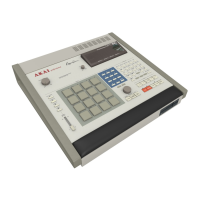
Do you have a question about the Akai MPC 60 and is the answer not in the manual?
| Manufacturer | Akai |
|---|---|
| Model | MPC 60 |
| Release Year | 1988 |
| Sampling Rate | 40 kHz |
| Bit Depth | 12-bit |
| Polyphony | 16 voices |
| Memory | 750 KB (expandable to 1.5 MB) |
| Storage | 3.5" floppy disk drive |
| Type | Sampler/Sequencer |
| Sequencer | Yes |
| Pads | 16 velocity-sensitive pads |
| MIDI | In/Out/Thru |
| Maximum Sampling Time | 13.1 seconds |
| Display | LCD |
| Outputs | 8 individual outputs, stereo output |
| Inputs | 2 inputs |
Details the necessary connections for the drum machine and sequencer sections.
Explains how to navigate and change data using the keypad, data control, and increment/decrement keys.
Details how to adjust individual drum volumes and pan settings using the mixer interface.
Details the main operating screen for recording and playback, including data fields.
Describes the TIMING CORRECT function for correcting timing errors and adding swing.
Explains how to erase notes and events in live erase mode or while stopped.
Details the process of creating a new sequence format, including time signature and loop settings.
Enables detailed editing of individual notes and events within a sequence.
Guides users through the process of sampling new sounds into the MPC60.
Explains how to modify parameters like start/end points, envelopes, and velocity.
Details the process of saving a single sequence to disk as a .SEQ file.
Explains how to save all sequences and songs into a single .ALL file.
Describes saving all drum sounds to disk as a single .SET file.
Explains how to manage files on disk: load, erase, and rename operations.
Details the SYNC screen parameters for various external sync input modes.
Explains how to record and play sequences in sync with SMPTE time code.
Explains MIDI input filtering, soft thru, and sustain pedal processing settings.
Provides troubleshooting steps and advice for resolving operational problems and software bugs.